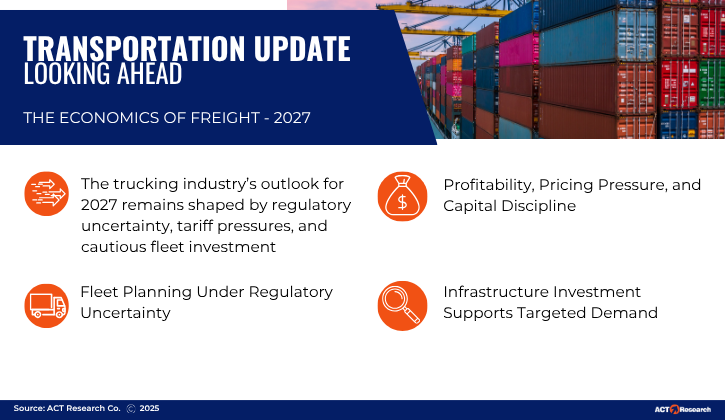
Trucking Industry 2027 Outlook
November 2025
Updated: November 21, 2025
The trucking industry’s outlook for 2027 remains defined by regulatory uncertainty, tariff-driven cost pressures, and restrained fleet investment. While signs of stabilization are emerging, long-term planning continues to be limited by weak freight fundamentals, recession-level carrier profitability, and unresolved emissions policy. The EPA’s 2027 low-NOx regulation remains the industry’s single largest unanswered question—as of mid-November, EPA has provided no guidance, and fleets broadly expect at least a partial delay or rollback. This lack of clarity, paired with escalating 232 tariff impacts, is suppressing any prebuy momentum and keeping fleet strategies focused on replacement, flexibility, and liquidity preservation.
Production and ordering data reflect this defensive stance. October Class 8 net orders remained well below seasonal norms during what is typically the strongest order month of the year. Medium-duty demand continues to underperform, and trailer orders—although showing a temporary lift in October—remain far below healthy levels as backlogs fall to multi-year lows. OEMs continue to operate with strict build discipline, cutting production to match lean orderboards and protect margins. Elevated inventories in vocational vehicles and declining freight volumes reinforce a market anchored in replacement activity rather than growth.
3 Key Trends Impacting Trucking & Transportation in 2027
1. Fleet Planning Under Regulatory Uncertainty
EPA 2027 compliance remains the most significant variable shaping fleet planning. With less than 14 months until the scheduled implementation date and no updated EPA guidance, fleet expectations continue shifting toward partial rule modifications—retaining technology requirements but delaying warranty and useful-life extensions. This has effectively halted prebuy strategies for 2026 and restrained long-term capital planning.
Tariff-induced cost inflation persists, as 232 heavy-vehicle tariffs now add substantial cost to new trucks—especially those with imported content. These increases are compounded by higher insurance and financing expenses, keeping total cost of ownership elevated. As a result, fleets are extending trade cycles, prioritizing essential replacement needs, and emphasizing flexibility over expansion as they prepare for yet another year of regulatory ambiguity.
2. Infrastructure Investment Supports Targeted Demand
Infrastructure-aligned freight remains one of the sector’s few stabilizing forces heading into 2027. Vocational demand, though soft in October and well off last year’s elevated levels, continues to benefit from utilities, municipal activity, and longer-cycle construction projects tied to federal funding. However, delays in project approvals and higher input costs have reduced upside potential.
Trailer market dynamics reinforce this theme. While October saw an improvement in orders, backlogs remain historically low, and OEMs describe 2026 orderboards as “below average but not dire.” Flatbed and platform equipment continue to show relative resilience tied to infrastructure, but broader vocational activity remains constrained by cautious fleet capex and uneven construction output. Selective purchasing and improved lead times support stability, but aggressive expansion remains unlikely.
3. Profitability, Pricing Pressure, and Capital Discipline
Carrier profitability remains deeply challenged entering 2027. Public TL carriers posted recession-like margins again in Q3, with profitability sitting at levels not seen since 2009–2010. Rate recovery remains limited, with spot rates softening again in early November as pre-tariff tightness unwinds and freight volumes trend lower. Contract rates show modest improvement but remain insufficient to offset rising operating and capital costs.
This profitability environment reinforces a disciplined investment posture across fleets. Capital budgets continue to favor maintenance, equipment life extension, and targeted efficiency improvements—including aerodynamics, idle reduction, and routing optimization—over capacity growth. With freight demand expected to remain soft into early 2026 and only gradual improvement anticipated later in the year, carriers remain focused on preserving liquidity and operational efficiency.
Until freight fundamentals strengthen and regulatory clarity emerges, the industry’s 2027 outlook remains defined by cost control, capital discipline, and cautious fleet strategies—a continuation of the slow, uneven normalization process underway since 2024.

Stay Ahead with Smarter Freight Insights
Success in trucking and freight comes from knowing what’s next—not just what’s now. At ACT Research, we deliver forward-looking market intelligence that helps you anticipate shifts, prepare for cycles, and stay strategically positioned. As your trusted transportation intelligence partner, we give you the tools to act with confidence—so you can optimize operations, reduce risk, and drive stronger profitability.